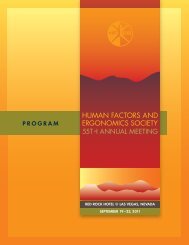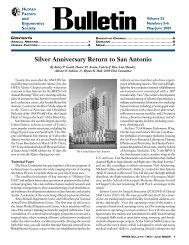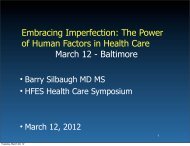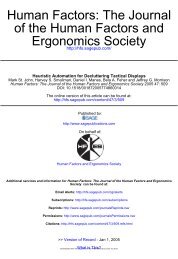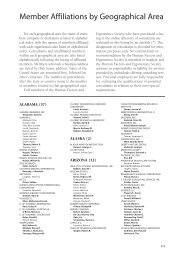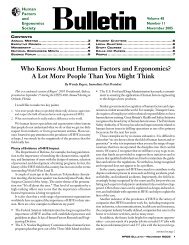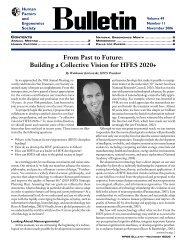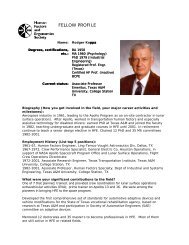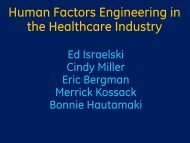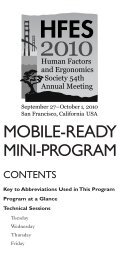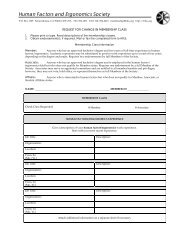March 2008 - Human Factors and Ergonomics Society
March 2008 - Human Factors and Ergonomics Society
March 2008 - Human Factors and Ergonomics Society
Create successful ePaper yourself
Turn your PDF publications into a flip-book with our unique Google optimized e-Paper software.
<strong>Human</strong><strong>Factors</strong><strong>and</strong><strong>Ergonomics</strong><strong>Society</strong>BulletinVolume 51Number 3<strong>March</strong> <strong>2008</strong>CONTENTSGOVERNMENT RELATIONS ...............................3IEA..........................................................4MEMBERSHIP ..............................................5TECHNICAL GROUPS ......................................5HUMAN FACTORS .........................................5JCEDM....................................................6HFES DIGITAL LIBRARY .................................6FINANCIAL REPORT .......................................7Improving Response to the Signsof Impending Heart AttacksBy Pamela Savage-Knepshield, HFES Bulletin Features Editor, <strong>and</strong> Mary Carol DayMost heart attacks start slowly <strong>and</strong> are accompanied by discomfort,mild pain, an “odd sensation,” or even a “funny feeling.”Often, those affected are not sure what is wrong <strong>and</strong> wait too longbefore getting help. Eliminating uncertainty, conveying severity,<strong>and</strong> providing ample time to seek medical attention could save acardiac patient’s life <strong>and</strong> prevent heart damage; however, the challengesof developing a device to address these goals raises severalsignificant human factors/ergonomics issues. These include howto reliably <strong>and</strong> effectively alert patients of an impending heartattack <strong>and</strong> how to ensure they correctly perceive <strong>and</strong> interpretsuch an alert.The following excerpts are from an interview with HFESFellow Mary Carol Day, in which she describes the AngelMedGuardian ® System <strong>and</strong> the HF/E support that it provides toensure that its users know whether to call 9-1-1 or their physicianwhen the system triggers an alert.What is the AngelMed Guardian ® System?The AngelMed Guardian system, developed by Angel MedicalSystems (http://www.angel-med.com), is an implantable cardiacmonitoring<strong>and</strong> -alerting system that is designed to warn cardiacpatients of potentially life-threatening heart conditions. TheGuardian system is currently in an initial feasibility study inthe United States.There are three major components of the Guardian system: theImplantable Medical Device (IMD), the External Device (EXD),<strong>and</strong> the Programmer.The IMD is implanted under the skin below the left collarbone,similar to a pacemaker. It continuously monitors the heart’selectrical activity (that is, the electrocardiogram). If it detects aspecific abnormality that indicates a possible heart attack, it vibratesin a particular sequential pattern to warn the patient to get immediatehelp. This alarm is called the Emergency alarm. In addition,the IMD vibrates using a different pattern, called the See Doctoralert, if the patient should see a doctor within the next couple ofdays to check on the IMD’s functioning.The EXD is a pager-sized external alarm device that the patientis instructed to keep close by at all times. When the IMDalarms, it communicates with the EXD, <strong>and</strong> the EXD provides anauditory alarm (beeps) <strong>and</strong> a visual alarm (flashing red or yellowlight) that are redundant with the vibratory alarm provided by theIMD. Also, the patient uses the EXD to turn off the alarms.The Programmer is a laptop used by medical staff to customizethe parameters of the IMD for each patient <strong>and</strong> to retrieve <strong>and</strong>store data from the IMD.How did you become involved in work on the AngelMedGuardian system?As you may know, the Food <strong>and</strong> Drug Administration is nowstrongly encouraging – <strong>and</strong> often requiring – usability engineeringfor medical devices in order to decrease the fairly high rate ofuse errors <strong>and</strong> their negative impact on patient health. Early inthe design of the Guardian system, AngelMed met with the FDAto discuss its primary features. The FDA encouraged AngelMed toget human factors expertise, which was considered especially importantbecause the alarms had to be well designed to ensure thatpatients could identify <strong>and</strong> correctly respond to the alarms. Angel-Med took the FDA’s advice seriously, <strong>and</strong> I was hired within amonth as the eighth employee of the company. We now have 2human factors professionals in a company of about 30 people.What challenges did you face providing HF/E support forthe design of the AngelMed Guardian system?There were two unique challenges for me personally. First, Ihad not previously worked in the medical field <strong>and</strong> needed to rapidlyunderst<strong>and</strong> the guidelines <strong>and</strong> expectations for human factorswork in the medical device industry. I started from the FDA’sWeb site on human factors (http://www.fda.gov/cdrh/humanfactors),which provided both FDA guidance documents <strong>and</strong> referencesto other st<strong>and</strong>ards. I was delighted to find that the processes recommendedby the FDA <strong>and</strong> international st<strong>and</strong>ards were textbookdescriptions of human factors involvement throughout a product’slifecycle. But my initial excitement was followed by the soberingrealization that there was no way I could do all of this.The second challenge was starting a human factors programfrom scratch on a new product that used a new alarm modality –that is, sequential patterns of vibratory pulses. This challenge wasboth organizational <strong>and</strong> technical. Within the company, therewere no existing human factors processes, <strong>and</strong> there had been nohuman factors input to initial product design. Also, there were noHFES BULLETIN • MARCH <strong>2008</strong> 1
Improving Response to the Signs of Impending Heart Attacks(continued from page 1)organizational expectations about what I should do beyond designof the alarms, <strong>and</strong> there was a general concern that there wouldnot be enough work for a full-time HF/E professional. Identifying<strong>and</strong> prioritizing the human factors work <strong>and</strong> then educating the organization<strong>and</strong> institutionalizing the processes were top priorities.The technical challenge concerned the design of sequentialvibratory alarm patterns. At the time, I could find very little researchin this area.What were the most challenging HF/E issues that youencountered during product design <strong>and</strong> development?How were they resolved?Probably the most challenging human factors issue was thedesign of the two vibratory alarms – the Emergency alarm <strong>and</strong>the See Doctor alert. These alarms needed to be distinctly differentfrom each other, have easily identifiable temporal patterns, be easilylearned <strong>and</strong> remembered, <strong>and</strong> have perceptual properties thatcorrespond to their meaning.My first step, of course, was to conduct a literature search. AlthoughI found research on basic vibration perception (for example,psychophysical studies of vibration thresholds), I found verylittle on the perception of sequential patterns of vibration <strong>and</strong> noneon subcutaneous vibration perception. However, the auditorywarnings literature identified auditory parameters that affectedperceived urgency. It seemed reasonable that some of the sameparameters would influence perceived urgency in the vibratorymodality – for instance, speed, number, <strong>and</strong> density.Based on the information from the literature search, I proposedseveral human factors studies to define the sequential patterns forthe Emergency alarm <strong>and</strong> See Doctor alert. Feedback from theFDA told us about IEC 60601-1-8, an international st<strong>and</strong>ard onalarm systems for medical electrical equipment. This documentprovided specific information for the characteristics of highpriority,medium-priority, <strong>and</strong> low-priority auditory alarms. Mygoal then became modifying the temporal parameters for the highpriority(Emergency) <strong>and</strong> low-priority (See Doctor) alarms tomake them appropriate for the vibratory modality.In the meantime, I identified a consultant with expertise invibration perception – Roger Cholewiak, formerly head of thePrinceton Cutaneous Communication Lab – <strong>and</strong> he has providedexpert advice <strong>and</strong> even equipment on a continuing basis.<strong>Human</strong> <strong>Factors</strong><strong>and</strong> <strong>Ergonomics</strong><strong>Society</strong>BulletinVolume 51, Number 3 <strong>March</strong> <strong>2008</strong>The HFES Bulletin (ISSN 1527-3660) is published 12 times a year by the <strong>Human</strong> <strong>Factors</strong><strong>and</strong> <strong>Ergonomics</strong> <strong>Society</strong>, 1124 Montana Ave., Suite B, Santa Monica, CA 90403 USA,http://hfes.org. Address inquiries <strong>and</strong> address changes to HFES, P.O. Box 1369, SantaMonica, CA 90406-1369 USA, 310/394-1811, fax 310/394-2410, http://hfes.org.Copyright © <strong>2008</strong> by the <strong>Human</strong> <strong>Factors</strong> <strong>and</strong> <strong>Ergonomics</strong> <strong>Society</strong>. Printed in the USA.The HFES Bulletin is provided to members of the <strong>Society</strong> ($10 of annual dues coversmember subscriptions); nonmembers may subscribe for $42/year. Periodicals postagepaid at Santa Monica, CA, <strong>and</strong> additional mailing offices. USPS #018-206.Briefly walk us through the research methods that you usedto ensure that the AngelMed Guardian’s vibratory alarmswere easy to distinguish.I conducted several experimental studies. The first of these wasdesigned to identify the best temporal characteristics for the vibratoryalarms <strong>and</strong> to ensure that the magnitude of the vibration wasappropriate. In these studies, participants were presented withEmergency alarms <strong>and</strong> See Doctor alerts with different temporalcharacteristics (that is, different pulse durations <strong>and</strong> interpulse intervals)<strong>and</strong> with alarms of different strengths. Participants providedmultiple ratings <strong>and</strong> judgments, such as strength ratings, strengthpreferences, urgency ratings, <strong>and</strong> temporal pattern preferences. Inone of the studies, I also compared two different auditory alarmfrequencies. It was exciting to find that similar characteristics affectperceived urgency for both vibratory <strong>and</strong> auditory alarms.Data from these studies were used to define temporal characteristicsfor the two alarm types. I then conducted a learning <strong>and</strong>memory study, in which participants were trained on the alarms inthe same way that a patient would be trained. Accuracy of alarmidentification was then assessed about 10 minutes after training <strong>and</strong>then six weeks after training.What do you feel was your most notable impact onthe project?Clearly, the design of the vibratory alarm patterns was critical.However, equally important has been identifying, prioritizing, <strong>and</strong>addressing the most important of the numerous human factorsissues for each of our three components (IMD, EXD, <strong>and</strong> Programmer)<strong>and</strong> continuously trying to keep the user’s needs in focusin an organization in which novel technology is essential for theproduct’s success.Based on lessons learned, what advice would you give to thehuman factors/ergonomics community?The medical field is a great place to be! It provides challengingwork that is inherently meaningful. Also, there is increasing recognitionof the need for human factors expertise in the design ofmedical products <strong>and</strong> processes. The National Academy of Sciences’Institute of Medicine estimates that between 44,000 <strong>and</strong>98,000 Americans die each year from preventable medical errors.For a human factors specialist moving into the medical field,I’d offer the following advice:• Obtain a solid background in human capabilities <strong>and</strong> limitations<strong>and</strong> in experimental <strong>and</strong> human factors methodologies.• Learn about methodologies that are especially important in themedical fields, such as approaches to risk analysis.• Refer to the relevant st<strong>and</strong>ards <strong>and</strong> guidelines.• Identify <strong>and</strong> learn domain-specific knowledge that is requiredto do a good job.• Consult experts on human factors topics for which you’re notan expert. <strong>Human</strong> factors colleagues, as well as other psychology<strong>and</strong> engineering professionals, are a great resource.Mary Carol Day is director of User Interface Systems at Angel MedicalSystems. Previously she was president of M. C. Day Consulting <strong>and</strong> atechnical manager at AT&T Bell Laboratories. She is a Fellow of HFES<strong>and</strong> a voting member of the AAMI <strong>Human</strong> <strong>Factors</strong> Engineering St<strong>and</strong>ardsCommittee.2 HFES BULLETIN • MARCH <strong>2008</strong>
GOVERNMENT RELATIONSHFES Government Relations:What, Why, <strong>and</strong> How?By William C. Howell, Chair, Government RelationsCommitteeAt its fall 2005 meeting, the HFES Executive Council decidedthat the <strong>Society</strong> should beef up its involvement in governmentaffairs to inform “national policy on matters in which HF/E has acontribution <strong>and</strong>/or interest.”I was asked to form a st<strong>and</strong>ing committee to this end. I agreed,on the condition that the tasking be changed from appointing a committeeto mounting an in-depth analysis of the government affairsactivities in which it is desirable <strong>and</strong> feasible for HFES to engage.My reasoning was that the st<strong>and</strong>ing committee route had beenpursued several times before with notable lack of success, largelybecause neither the functions nor the committee’s role had everbeen clearly articulated.I was not eager to reprise the ever-popular “appoint a committee<strong>and</strong> hope for the best” tune. My conditions were accepted, <strong>and</strong>in collaboration with a small, savvy advisory group that includedHFES Executive Director Lynn Strother, the next year <strong>and</strong> a halfwere spent analyzing <strong>and</strong> formulating recommendations that wereultimately approved by Council. We did recommend a st<strong>and</strong>ingcommittee but, unlike its predecessors, one with limited <strong>and</strong> clearlydefined responsibilities.The new Government Relations Committee (GRC) was appointed– Jerry Krueger, Laurel Allender, David Kobus, SusanMeadows, Douglas Gillan, <strong>and</strong> the executive director ex officio –<strong>and</strong> has busied itself over the past year developing procedures whileconcurrently trying them out. Because gathering <strong>and</strong> coordinatinginformation is central to any viable government relations effort,the GRC has focused a lot of attention on how best to do this.The entire HFES membership is a potential source of information,so we felt it was time to fill you in <strong>and</strong> enlist your support <strong>and</strong>participation in this endeavor. The present article is thus an introductionto what we hope will be a continuing dialogue with <strong>Society</strong>members.Brief HistoryThe fact that the U.S. federal government played a major rolein the creation <strong>and</strong> evolution of human factors/ergonomics iscommon knowledge. The convergence of design <strong>and</strong> behavioralscience disciplines under the exigency of war, sustained thereafterlargely through direct <strong>and</strong> indirect support from the nation’s defenseestablishment, has morphed into a recognized field that contributesto <strong>and</strong> is funded by myriad public <strong>and</strong> private institutions.The once rather simple relationship between government <strong>and</strong>the field (i.e., federal support of mostly defense R&D) has becomeincreasingly complex – encompassing legislation, jurisprudence,industry st<strong>and</strong>ards, <strong>and</strong> government regulations – applied in virtuallyevery setting in which human activity is involved (militarysystems, transportation, health care, manufacturing, city planning,communications, <strong>and</strong> countless others).As a consequence, there are now many routes through whichgovernment policy can affect HF/E, <strong>and</strong> vice versa. Some, such asregulations governing workplace or aviation safety, are open <strong>and</strong>obvious. Others, such as neglect of HF/E considerations in appropriationsbills or the setting of agency priorities, are often knownonly to a few “insiders” who are either directly affected or privyto the opaque processes by which public policy sausage is made.Although from the beginning there have been individuals <strong>and</strong>isolated groups within the HF/E community who have been activein government affairs, their focus has typically been limited toissues directly affecting their immediate surroundings. Militarycontractors scrutinize defense appropriations bills, human factorsspecialists employed by the civilian agencies fight for their shareof the agency’s budget, highway safety researchers push theiragenda with congressional oversight committees or Department ofTransportation agencies, <strong>and</strong> so on.Representatives of the field have also become increasingly visibleon government advisory bodies, <strong>and</strong> an entire committee of theprestigious National Research Council – the Committee on <strong>Human</strong><strong>Factors</strong> – is dedicated to HF/E issues. But engagement bythe field as a whole was never seriously considered until it surfacedwithin HFES as an issue – <strong>and</strong> initially a rather controversialone – several decades ago. The opposition weakened over time,<strong>and</strong> by the mid-1980s the majority view favored some sort of corporateadvocacy effort, but opinions still differed on how big itshould be <strong>and</strong> what form it should take.The <strong>Society</strong> joined an advocacy consortium, the Federation ofBehavioral, Psychological, <strong>and</strong> Cognitive Sciences (FBPCS), butwithdrew shortly thereafter due to complaints that FBPCS didn’tadequately represent HFES interests. Later it rejoined, has been anactive participant ever since, <strong>and</strong> over the years has worked withseveral consortia representing other HF/E interest areas.Despite its growing involvement in government affairs, however,HFES has had difficulty finding an effective way to institutionalizeits efforts. For one thing, the leaders (presidents <strong>and</strong>Executive Councils) who raised the issue typically lacked the necessaryexpertise in government affairs to make informed decisions,<strong>and</strong> for another, a lot was being accomplished quietly throughinformal means without the benefit of any such structure. Nevertheless,the feeling that the <strong>Society</strong> should “do more,” without anysense of what that might realistically entail, persisted <strong>and</strong> led tothe abortive st<strong>and</strong>ing committee efforts noted earlier. By contrast,the present GRC was appointed only after the groundwork waslaid through which its mission <strong>and</strong> role within the HFES decisionstructure could be clearly defined.New GRC’s Mission <strong>and</strong> RoleThe GRC’s first task, therefore, was to review <strong>and</strong> classifygovernment relations activities in which HFES has been or is currentlyengaged <strong>and</strong> to consider where authority for engaging <strong>and</strong>determining responsibility for executing them should reside. Itssecond task was to determine how the GRC could best fit intothis picture.Each of these tasks resulted in a formal document submitted toCouncil for endorsement that was subsequently adopted into thecontinued on next pageHFES BULLETIN • MARCH <strong>2008</strong> 3
GOVERNMENT RELATIONS, cont.HFES Operating Rules. Corporate government relations activitiesfall into four general categories: (a) interorganizational relationships,(b) information gathering, (c) reacting (which includes fivesubcategories), <strong>and</strong> (d) initiating action proactively. The GRC’srole in these activities is primarily that of supporting <strong>and</strong> advisingthe authorized HFES decision makers (especially the president,Council, domain leaders, technical groups, <strong>and</strong> the executive director),not actually making or implementing corporate decisions.Foremost among the GRC functions is the establishment <strong>and</strong>oversight of processes for gathering, evaluating, integrating, <strong>and</strong>disseminating information with which to advise decisions on whatpolicy issues the <strong>Society</strong> should address <strong>and</strong> how to address them.In the past, issues came to the <strong>Society</strong>’s attention mainly throughits interorganizational relationships (e.g., requests from FBPCS to“sign on” to collective actions) or the chance interaction of a concernedmember with some HFES official.The intent of the GRC initiative is to replace happenstancewith systematization in the identification <strong>and</strong> h<strong>and</strong>ling of suchpolicy matters.Building the SystemBy virtue of representing the field’s major interest areas, theHFES technical groups (TGs) constitute the obvious place to startin building a comprehensive intelligence network. Therefore, weare in the process of establishing a working relationship with allTGs through which to keep tabs on developments in their respectiveHF/E domains.Through a designated point of contact in each TG, the GRCwill compile <strong>and</strong> periodically update a file of all issues <strong>and</strong> topicswith policy implications. Each entry will consist of a one-pagedescription of the issue/topic, along with the TG’s assessment ofits urgency <strong>and</strong> any recommendations it wishes to offer for corporateh<strong>and</strong>ling. From this compendium, the GRC will select themost pressing <strong>and</strong>/or promising targets for action <strong>and</strong> forward itsrecommendations to the appropriate HFES decision agency (asnow specified in the Operating Rules). Depending on the actioninvolved, TGs also may be called upon to identify experts, preparebackground information, or participate in other ways in executinga game plan.In addition to enabling the <strong>Society</strong> to invest its limited resourceswisely by engaging targets of highest priority, this compendiumwill permit more informed, timely responses to the unanticipatedtime-sensitive opportunities from external sources that have becomefairly common in recent years.After it’s up <strong>and</strong> running, the TG network will also provide aconvenient route through which individual members can bringtheir issues to the <strong>Society</strong>’s attention. A TG’s backing, of course,would typically strengthen one’s case.However, this in no way precludes direct input. We recognizethat some issues may fall between the cracks in the TG network,<strong>and</strong> time constraints or other circumstances might also favor thedirect route. Members are welcome to discuss any such issues withme (william.c.howell asu.edu) or HFES Executive Director LynnStrother (lynn hfes.org).Where’s the Beef?To this point, government relations “issues” <strong>and</strong> “actions” havebeen discussed only in the abstract, <strong>and</strong> I realize that it is difficultto appreciate how HFES figures into the policy picture withoutconcrete examples. Space limitations preclude doing justice to suchillustrations here, so this will be the focus of a future article. As apreview, however, I’ll close with two recent examples.An HFES-sponsored briefing on human factors in driver safetywas held in the U.S. House of Representatives in November2007 <strong>and</strong> was reported by GRC member Jerry Krueger in the January<strong>2008</strong> issue of the HFES Bulletin.In December 2007, a letter from the executive director to theSpeaker of the Colorado State Senate, written in consultation withthe GRC, provided HF/E contact <strong>and</strong> reference information fora hearing on voting machine decertification. The contacts weremade, <strong>and</strong> as a consequence the legislature had the benefit of thehuman factors perspective in its deliberations.The GRC is currently working within the <strong>Society</strong> structuretoward compiling a set of position papers on “hot topics” such asthese to inform policy in a variety of government venues.William C. (Bill) Howell is retired but holds adjunct faculty appointmentsat Arizona State University (Polytechnic Campus) <strong>and</strong> Rice University<strong>and</strong> serves on several national advisory boards.IEANominations Sought forIEA/Liberty Mutual MedalBy William S. Marras, Chair, HFES IEA RepresentativesCommitteeThe International <strong>Ergonomics</strong> Association (IEA) is acceptingentries for the IEA/Liberty Mutual Medal. The award recognizesoutst<strong>and</strong>ing original research leading to the reduction of workrelatedinjuries <strong>and</strong>/or the advancement of theory, underst<strong>and</strong>ing,<strong>and</strong> development of occupational safety research.The medal has been restructured for <strong>2008</strong>, replacing the previousIEA/Liberty Mutual Prize <strong>and</strong> IEA/Liberty Mutual Medal.The new medal will be awarded annually to the author of an originalpaper that meets criteria for innovation <strong>and</strong> impact. This isthe most prestigious award of its kind in the field of occupationalergonomics <strong>and</strong> safety <strong>and</strong> carries a stipend of $10,000. The winner’swork will be presented at the IEA’s Council meeting, to beheld this summer in Reykjavík, Icel<strong>and</strong>.The deadline for entries is May 31, <strong>2008</strong>. Applicants will benotified of the results by mid-July. Announcement of the awardwinner will be made public on August 31, <strong>2008</strong>.Additional information on the IEA/Liberty Mutual Medal canbe found at http://www.iea.cc/browse.php?contID=libertymutual_prize.For a list of frequently asked questions about the IEA/Liberty MutualMedal, please visit http://www.iea.cc/browse.php?contID=faq.4 HFES BULLETIN • MARCH <strong>2008</strong>
MEMBERSHIPShare the Benefits of HFESMembershipYou know the value of your HFES membership, but do yourfriends <strong>and</strong> colleagues who have an interest in human factors/ergonomics? They too can benefit from the complimentary subscriptionsto our regular publications <strong>and</strong> discounts on books, proceedings,st<strong>and</strong>ards, <strong>and</strong> annual meeting registration. In addition, allHFES members are entitled to the following:• free access to the HFES Digital Library-Archive• members-only access to the HFES Career Center for résuméposting <strong>and</strong> job searching (http://www.hfes.org/web/CareerCenter/Career.aspx)• 20% off software, workload assessment tools, data analysistools, <strong>and</strong> other products from the <strong>Human</strong> Systems InformationAnalysis Center (formerly CSERIAC)• 15% off Taylor & Francis books <strong>and</strong> subscriptions to <strong>Ergonomics</strong>• 15% off John Wiley & Sons books <strong>and</strong> other resources• 15% off selected books from Academic Press• discounts on car rentals from Alamo <strong>and</strong> HertzLet your colleagues know that they can apply online at http://hfes.org, <strong>and</strong> credit card transactions are secure.Spread the word: HFES membership is an excellent value <strong>and</strong>an invaluable resource for anyone working or interested in theHF/E field!TECHNICAL GROUPSCall for Nominations <strong>and</strong> Judges:User-Centered Design AwardBy Dianne McMullin <strong>and</strong> Stan Caplan, PDTG AwardCochairsThe Product Design Technical Group (PDTG) welcomesyour submissions for the 7th Annual User-Centered Product DesignAward. The award will emphasize both product design <strong>and</strong>methods used to specify <strong>and</strong> achieve the design. Emphasis will beplaced on innovative <strong>and</strong> user-centered approaches to human factors<strong>and</strong> industrial design.Consideration is limited to products, software, or systems thatare purchased for use in the home, in the workplace, or whilemobile. They include consumer, commercial, <strong>and</strong> medical productsbut exclude military equipment or systems. The product orsystem being nominated must be operational <strong>and</strong> capable of beingmarketed with no more than minimal changes. Products alreadyon the market for more than three years will not be considered.Nominations may be submitted for your own work or that ofothers. At least one team member who contributed significantly tothe project must be a member of HFES, but membership in thePDTG is not required. Nominations should be submitted in electronicform by a human factors professional. Detailed submissionrequirements, including the submission format, are shown on thePDTG Web site, http://pdtg.hfes.org. More information concerningPDTG <strong>and</strong> previous User-Centered Product Design Awardwinners can also be found on the Web site.The deadline for submitting nominations is April 25, <strong>2008</strong>.Nominations should be submitted electronically to Dianne Mc-Mullin at dianne.l.mcmullin boeing.com.The winning product/system will be recognized at the <strong>2008</strong>HFES Annual Meeting, <strong>and</strong> the awardees will be asked to presenta talk on the product <strong>and</strong> methodology. Awardees will also beexpected to submit a paper to <strong>Ergonomics</strong> in Design within twomonths of the meeting.Call for JudgesAn award selection committee consisting of a panel of judgesdrawn from the PDTG membership will evaluate the submissions.Judges may award multiple winners or a combination of winners<strong>and</strong> honorable mentions. Judging will be done by a predetermined,systematic process <strong>and</strong> will take place in June.Please contact Stan Caplan at scaplan usabilityassociates.com for more information or to volunteer for the award selectioncommittee.HUMAN FACTORS<strong>Human</strong> <strong>Factors</strong> Editor C<strong>and</strong>idatesSoughtThe term of the current editor of <strong>Human</strong> <strong>Factors</strong> will expire atthe end of <strong>2008</strong>, <strong>and</strong> HFES is seeking c<strong>and</strong>idates for the position.The <strong>Human</strong> <strong>Factors</strong> editor’s term is four years (2009–2012),with the possibility of two additional two-year terms. The incomingeditor will be asked to work with the outgoing editor in thelatter part of <strong>2008</strong>, so on each end of the tenure there will be a fewmonths of overlap to enable a smooth transition.Desirable c<strong>and</strong>idates should have prior experience workingwith authors of scientific research, including a demonstrated abilityto communicate sometimes unwelcome news with consideration,tact, <strong>and</strong> diplomacy.Administrative support for the manuscript review process isprovided in the HFES central office in Santa Monica. The <strong>Society</strong>’spublications staff also performs production editing of thejournal. Questions about these functions may be directed to CommunicationsDirector Lois Smith (310/394-1811, lois hfes.org).If you are interested in being considered for the <strong>Human</strong> <strong>Factors</strong>editorship, please log on to the journal page of the HFES Website (http://www.hfes.org/web/pubpages/hfeditorselection.html), whereyou will find further instructions. Please forward a current CV,letter of interest, responses to the questions posted at the Website, <strong>and</strong> two professional or personal recommendation letters toLois Smith by April 30, <strong>2008</strong>. The HFES Publications Committeewill conduct telephone interviews with qualified c<strong>and</strong>idates in May<strong>and</strong> make a recommendation to the Executive Council in September.HFES BULLETIN • MARCH <strong>2008</strong> 5
JCEDMJCEDM Special SectionBy Mica R. Endsley, Editor-in-ChiefWe invite papers for a special section of the Journal of CognitiveEngineering <strong>and</strong> Decision Making, “Developing <strong>and</strong> Underst<strong>and</strong>ingComputational Models of Macrocognition.”A growing number of cognitive modelers <strong>and</strong> computer scientistsare directing their efforts toward underst<strong>and</strong>ing <strong>and</strong> representingmacrocognitive processes. Consequently, the literatureacross a wide variety of disciplines – human factors, cognitive psychology,human behavior representation, artificial intelligence(AI), operations research, <strong>and</strong> human-computer interaction, toname only a few – is now teeming with discussions of novel computationalarchitectures.Though many might see this as an interesting departure fromthe application of AI techniques to classic experimental paradigmsin cognitive psychology, this turn also raises a host of interestingissues. For instance, research in macrocognition embraces phenomena<strong>and</strong> methods that might seem abstract or imprecise tothose coming from a more traditional background in computationalcognitive modeling. Conversely, to the macrocognitive researcher,computational cognitive models are likely to be seen ascouched in too finely grained a scale – exactly at the “micro” levelto which the macrocognitive researcher is reacting. There is noreason to assume that these micro <strong>and</strong> macro views are incommensurable,but a good deal of work needs to be done to show howthey are best reconciled.The goal of this special section of JCEDM is to begin this workby soliciting manuscripts from researchers in a range of disciplineswho are developing computational representations of macrocognitiveprocesses directly or are contributing to this body of work bydevelopment of theory, experimentation, or practice. To encouragethe ongoing exchange of ideas across disciplines, our aim withthis special section will not be to justify or reaffirm the importanceof a macrocognitive perspective, nor will it be to establish prioritiesamong various computational architectures. Rather, takingmacrocognition as a starting point, we seek manuscripts that detailhow various aspects of the theory have begun to find expressionin computational architectures.Suggested paper topics include the following:• presentations of new <strong>and</strong> innovative architectures representingspecific macrocognitive processes (e.g., recognitional decisionmaking, actionable models of situation awareness, problemdetection) <strong>and</strong> their application to real-world problems;• discussion of the correspondence between conceptual <strong>and</strong>computational models <strong>and</strong> of the relationship between macro<strong>and</strong>microcognitive models of cognition;• methods for measuring <strong>and</strong> evaluating computational modelsof macrocognitive processes; <strong>and</strong>• methods for validating both conceptual <strong>and</strong> computationalmodels of macrocognition.Prepare manuscripts according to the JCEDM guidelines,which follow the Publication Manual of the American PsychologicalAssociation (5th ed.). Manuscripts should not exceed 25 pages inlength <strong>and</strong> should be submitted electronically to cedm.journalsatechnologies.com, with the subject line, “Submission for SpecialIssue on Computational Models of Macrocognition.”The closing date for submissions is June 27, <strong>2008</strong>. If you haveany questions, please contact Special Section Coeditors WalterWarwick (wwarwick alionscience.com), Laurel Allender (lallendearl.army.mil), or John Yen (jyen ist.psu.edu).HFES DIGITAL LIBRARYBack Issues SoughtThe HFES Communications Department is seeking a fewmissing issues <strong>and</strong> volumes for the Digital Library-Archive. Ifyou have any of the following issues, please contact CommunicationsDirector Lois Smith at lois hfes.org or call 310/394-1811.Thank you!<strong>Human</strong> <strong>Factors</strong>Volume 24 (1982), Numbers 2 <strong>and</strong> 6Volume 25 (1983), Numbers 1, 2, <strong>and</strong> 3Volume 26 (1984), Number 5HFES Annual Meeting Proceedings1972, 1973, 1976–1981Florida TechCollege of AeronauticsFaculty MemberFull Time <strong>Human</strong> <strong>Factors</strong>Undergraduate & Graduate Aviation Programs• Doctoral Degree in applicable field• Experience in university teaching, aviation, proposalwriting, program management, instructional technologyin classroom & distance learning.Application package to consists of:•1 resume or CV including research• (3) professional references with contact informationOn request applicants will need to provide academic transcriptsfor all degrees.Submit to: koyman@fit.edu or Fax to 321-674-8059Mail: Dr. Korhan OymanFlorida TechCollege of Aeronautics150 West University Blvd.Melbourne, FL 32901-6975Florida Institute of Technology is an equal opportunity employercommitted to excellence through diversity.6 HFES BULLETIN • MARCH <strong>2008</strong>
FINANCIAL REPORT2006 Financial ReportThe <strong>Human</strong> <strong>Factors</strong> <strong>and</strong> <strong>Ergonomics</strong> <strong>Society</strong>’s2006 audited financial report, receivedby Secretary-Treasurer Valerie J. Gawron inDecember 2007, was prepared by Castillo &Associates, an accountancy corporation. Thefirm audited the following statement of assets<strong>and</strong> liabilities – cash basis – of the <strong>Human</strong> <strong>Factors</strong><strong>and</strong> <strong>Ergonomics</strong> <strong>Society</strong> (a nonprofit organization)at December 31, 2006, <strong>and</strong> the relatedstatements of revenues <strong>and</strong> expenses – cash basis,<strong>and</strong> of changes in fund balance – cash basisfor the 12 months then ended. These financialstatements are the responsibility of the <strong>Human</strong><strong>Factors</strong> <strong>and</strong> <strong>Ergonomics</strong> <strong>Society</strong>’s management.The firm’s responsibility is to express an opinionon these financial statements based on its audit.In addition to the regular <strong>Society</strong> funds, thefirm reviewed the A. Chapanis Award Funds.These funds had a balance of $22,742 at January1, 2006; at December 31, 2006 the balancewas $25,161.The firm conducted its audit in accordancewith generally accepted auditing st<strong>and</strong>ards.Those st<strong>and</strong>ards require that the firm plan <strong>and</strong>perform the audit to obtain reasonable assuranceabout whether the financial statements arefree of material misstatement. An audit includesexamining, on a test basis, evidence supportingthe amounts <strong>and</strong> disclosures in the financialstatement. An audit also includes assessing theaccounting principles used <strong>and</strong> significant estimatesmade by management, as well as evaluatingthe overall financial statement presentation.The firm believes that its audit provides a reasonablebasis for its opinion.As described in Note1, these financial statementswere prepared on the basis of cashreceipts <strong>and</strong> disbursements, which is a comprehensivebasis of accounting other than generallyaccepted accounting principles.In the firm’s opinion, the financial statementsreferred to above present fairly, in all materialrespected, the assets, liabilities, <strong>and</strong> fundbalances of the <strong>Human</strong> <strong>Factors</strong> <strong>and</strong> <strong>Ergonomics</strong><strong>Society</strong> as of December 31, 2006, <strong>and</strong> itsrevenue, expenses, <strong>and</strong> the changes in its fundbalances for the twelve months then ended, inconformity with the basis of accounting describedin Note 1.Statement of Assets <strong>and</strong> Liabilities – Cash BasisDecember 31, 2006AssetsCash on depositBank of America . . . . . . . . . . . . . . . . . . . . . . $742,097Total Cash on Deposit . . . . . . . . . . . . . . . . . . $742,097InvestmentsVanguard STAR Fund, at cost (Note 7). . . . . . $170,379Total assets . . . . . . . . . . . . . . . . . . . . . . . . . $912,476Liabilities <strong>and</strong> Fund BalanceReserve for current payable (Note 3) . . . . . . . $ 12,000Due to TG . . . . . . . . . . . . . . . . . . . . . . . . . . . 50,000Payroll liabilities . . . . . . . . . . . . . . . . . . . . . . . 73Total liabilities . . . . . . . . . . . . . . . . . . . . . . . . 62,073Fund balance . . . . . . . . . . . . . . . . . . . . . . . . 850,403Total liabilities <strong>and</strong> fund balance. . . . . . . . . $912,476Statement of Changes in Fund Balance – Cash Basisfor the 12 Months Ended December 31, 2006Balance - January 1, 2006 . . . . . . . . . . . . . . . $671,159Less: excess of expenses over revenues . . . . (179,244)Balance - December 31, 2006 . . . . . . . . . . . $850,403Statement of Revenues <strong>and</strong> Expenses – Cash Basisfor the 12 Months Ended December 31, 2006RevenuesIndividual memberships . . . . . . . . . . . . . . . . $ 674,496Sustaining memberships . . . . . . . . . . . . . . . 6,000Publications. . . . . . . . . . . . . . . . . . . . . . . . . 430,541HFES Institute . . . . . . . . . . . . . . . . . . . . . . . 18,404Annual Meeting . . . . . . . . . . . . . . . . . . . . . . 337,234Placement. . . . . . . . . . . . . . . . . . . . . . . . . . 81,588Net unrealized gains on investments . . . . . . 7,371Miscellaneous . . . . . . . . . . . . . . . . . . . . . . . 32,401Total revenues . . . . . . . . . . . . . . . . . . . . . $1,588,035ExpensesPublication Expenses:HFES Bulletin . . . . . . . . . . . . . . . . . . . . . . . . $ 38,705<strong>Human</strong> <strong>Factors</strong> . . . . . . . . . . . . . . . . . . . . . . . 124,585Directory <strong>and</strong> Yearbook . . . . . . . . . . . . . . . . . 42,616<strong>Ergonomics</strong> in Design . . . . . . . . . . . . . . . . . . 59,936Books . . . . . . . . . . . . . . . . . . . . . . . . . . . . . . 12,606Proceedings . . . . . . . . . . . . . . . . . . . . . . . . . 809Other publication expense . . . . . . . . . . . . . . . 17,667Total publication expense . . . . . . . . . . . . . . $299,890Member Services:Mailings expenses. . . . . . . . . . . . . . . . . . . . . $ 19,331Placement Service . . . . . . . . . . . . . . . . . . . . 36,251Committee <strong>and</strong> other (Note 4) . . . . . . . . . . . . 140,643Annual Meeting . . . . . . . . . . . . . . . . . . . . . . . 93,560Member Services . . . . . . . . . . . . . . . . . . . . . 39,923Computer, Web site, & related expenses . . . . 37,633Interorganizational. . . . . . . . . . . . . . . . . . . . . 26,394Total Member Services . . . . . . . . . . . . . . . . $393,735General <strong>and</strong> Administrative Expense:Salaries <strong>and</strong> related costs . . . . . . . . . . . . . . . $566,925Office expense . . . . . . . . . . . . . . . . . . . . . . . 140,586Accounting <strong>and</strong> legal . . . . . . . . . . . . . . . . . . . 7,655Total General <strong>and</strong> Administrative Expense $715,166Total Expenses. . . . . . . . . . . . . . . . . . . . . $1,408,791Excess of revenues over expenses . . . . . . $179,244Note 1 – Summary of Significant Accounting PoliciesThis summary of significant accounting policies of<strong>Human</strong> <strong>Factors</strong> <strong>and</strong> <strong>Ergonomics</strong> <strong>Society</strong>, Inc. (the organization)is presented to assist in underst<strong>and</strong>ing theorganization’s financial statements. The financial statements<strong>and</strong> notes are representations of the organizationwho is responsible for their integrity <strong>and</strong> objectivity.Activity. The organization is a nonprofit entity. Theorganization is an interdisciplinary organization of professionalworkers concerned with the role of humans incomplex systems, the design of equipment <strong>and</strong> facilitiesfor human use, <strong>and</strong> the development of environmentsfor comfort <strong>and</strong> safety. The membership is composedof psychologists, engineers, physiologists, <strong>and</strong> other scientistsfrom the United States <strong>and</strong> around the world.<strong>Human</strong> <strong>Factors</strong> <strong>and</strong> <strong>Ergonomics</strong> <strong>Society</strong>, Inc. promotesresearch <strong>and</strong> the application of human factors inthe design, development, use, <strong>and</strong> evaluation of machines,systems, environments, <strong>and</strong> devices.Basis of accounting. The organization’s policy is toprepare its financial statements on the cash basis of accounting;consequently, certain revenues are recognizedwhen received rather than when earned, <strong>and</strong> certainexpenses <strong>and</strong> purchases of assets are recognized whencash is disbursed rather than when the obligation isincurred.Note 2 – Property <strong>and</strong> EquipmentIt is the organization’s policy to expense all capitalassets purchased throughout the year.Note 3 – Reserve for Current PayableThis represents a segregation of surplus for bills dueat December 31, 2006. This represents $12,000 for miscellaneouspayables.Note 4 – Committee <strong>and</strong> Other50th Anniversary . . . . . . . . . . . . . . . . . . . . . . . $16,573IEA Representative . . . . . . . . . . . . . . . . . . . . . 4,705Awards . . . . . . . . . . . . . . . . . . . . . . . . . . . . . . 3,324Media Relations . . . . . . . . . . . . . . . . . . . . . . . 1,307Outreach Advisory. . . . . . . . . . . . . . . . . . . . . . 42,496Student Affairs. . . . . . . . . . . . . . . . . . . . . . . . . 4,874Miscellaneous . . . . . . . . . . . . . . . . . . . . . . . . . 7,516HFES Institute. . . . . . . . . . . . . . . . . . . . . . . . . 27,780Executive Council . . . . . . . . . . . . . . . . . . . . . . 32,068$140,643Note 5 – Concentrations of Credit RiskThe organization maintains its cash balances at severalfinancial institutions located in Santa Monica, California.Accounts at each institution are insured by theFederal Deposit Insurance Corporation up to $100,000.At December 31, 2006, there was an uninsured cash balanceof $642,097.Note 6 – Pension PlanThe organization has a tax-deferred annuity planusing Teachers Insurance <strong>and</strong> Annuity Association-College Retirement Equities Fund (TIAA-CREF) Annuitiesthat meet the requirements of section 403(b)(1) ofthe Internal Revenue Code.Benefits are provided by individually insured contractsissued by TIAA-CREF to each participant. Theguaranteed rate basis for premiums applied to TIAARetirement Annuity contracts is in accordance with theterms of the participant’s individual annuity contract.The plan is a defined contribution plan, which coversall full-time employees with two years of service. Theplan calls for contributions of 10% of compensation forparticipants for the first three years in the plan <strong>and</strong> 12.5%of compensation thereafter.Note 7 – InvestmentsThe organization has the following mutual fund withthe Vanguard Group.Fair MarketCost Value9,136.539 shares ofVanguard STAR Fund $163,008 $170,379Note 8 – Income Tax StatusThe organization is exempt from federal income taxunder Section 501(c)(3) of the Internal Revenue Code.However, income from certain activities not directly relatedto the organization’s tax-exempt purpose is subjectto taxation as unrelated business income. For 2006, theorganization had no tax on unrelated business income. Inaddition, the organization qualifies for the charitable contributiondeduction under Section 170(b)(1)(A) <strong>and</strong> hasbeen classified as an organization other than a privatefoundation under Section 509(a)(2).HFES BULLETIN • MARCH <strong>2008</strong> 7
NowOnline:::::HFES DIGITALLIBRARY-ARCHIVE ■ ■ ■ ■ ■ ■ ■ ■ ■ ■ ■ ■ ■The <strong>Human</strong> <strong>Factors</strong> <strong>and</strong> <strong>Ergonomics</strong> <strong>Society</strong> is proud to bring you a newmember benefit: the HFES Digital Library-Archive. The HFES DL containsolder volumes* of these titles:■ <strong>Human</strong> <strong>Factors</strong>: The Journal of the <strong>Human</strong> <strong>Factors</strong> <strong>and</strong> <strong>Ergonomics</strong> <strong>Society</strong>■ <strong>Ergonomics</strong> in Design: The Quarterly of <strong>Human</strong> <strong>Factors</strong> Applications■ Journal of Cognitive Engineering <strong>and</strong> Decision Making (with current-yearsubscription)■ Proceedings of the <strong>Human</strong> <strong>Factors</strong> <strong>and</strong> <strong>Ergonomics</strong> <strong>Society</strong> Annual Meeting■ Reviews of <strong>Human</strong> <strong>Factors</strong> <strong>and</strong> <strong>Ergonomics</strong> (with current-year subscription)HFES MEMBERS: You’ll have free access to the older issues* of these titles!If you think your colleagues or corporate or university library might be interested inthe HFES Digital Library-Archive, let them know that HFES is making this excellentcollection available at low rates:Nonmembers: ................................... $750 Institutions: ................................. $1,5002009 rates:.................................................. $950 for nonmembers, $1,900 for institutionsHere’s what you’ll be able to access during the 3-year back volume digitization project:Titles 2007 Content <strong>2008</strong> Content 2009 Content<strong>Human</strong> <strong>Factors</strong> 1993–2004 1980–2005 1958–2006<strong>Ergonomics</strong> in Design 1993–2004 1993–2005 1993–2006JCEDM NA NA 2007Proceedings 1993–2004 1980–2005 1972–2006Reviews of HF/E NA NA 2006NONMEMBERS: If you’d like to join HFES to receive access privileges to the DigitalLibrary-Archive, visit the Membership section of our Web site at http://www.hfes.org/Web/Membership/howtojoin.html. Anyone can be a member of HFES, <strong>and</strong> the onlineapplication process is simple <strong>and</strong> secure.*Members: Choose either the print or online version of the current year’s issues of <strong>Human</strong> <strong>Factors</strong> <strong>and</strong> <strong>Ergonomics</strong>in Design at no charge as part of your member benefits package. The current year’s issues of Journalof Cognitive Engineering <strong>and</strong> Decision Making, Annual Meeting Proceedings, <strong>and</strong> Reviews of <strong>Human</strong> <strong>Factors</strong><strong>and</strong> <strong>Ergonomics</strong> may be purchased at special member rates.BulletinHF ESVolume 51, Number 3 <strong>March</strong> <strong>2008</strong>Features Editor: Pamela Savage-KnepshieldCommunications Director: Lois SmithAssistant Managing Editor: Jason DeanAdvertising: R. C. Bublitz & Associates,800/485-5029; dick-rcb juno.comPOSTMASTER:Send address changes to the HFES Bulletin,<strong>Human</strong> <strong>Factors</strong> <strong>and</strong> <strong>Ergonomics</strong> <strong>Society</strong>,P.O. Box 1369, Santa Monica, CA 90406-1369 USA,310/394-1811, fax 310/394-2410, http://hfes.orgGeneral Information: info hfes.orgEditorial/Advertising: lois hfes.orgPlacement Service: placement hfes.orgAnnual Meeting: lois hfes.org! F L A S H!<strong>2008</strong> HFES Officer Elections – Nominationballots for HFES officers <strong>and</strong> ExecutiveCouncil members will be mailed <strong>March</strong> 28.Completed ballots are due at the HFES CentralOffice on April 23.Midyear Meeting – The Executive CouncilMidyear Meeting will take place April 25–27at Loews Hotel, Philadelphia, PA.Update Your Membership Information– You can update your member recordby logging in at http://hfes.org or by notifyingMember Services (membership@hfes.org,310/394-1811, fax 310/394-2410).Opinions expressed in BULLETIN articles are those of the authors <strong>and</strong> should not be consideredas expressions of official policy by the <strong>Human</strong> <strong>Factors</strong> <strong>and</strong> <strong>Ergonomics</strong> <strong>Society</strong>.<strong>Human</strong> <strong>Factors</strong> <strong>and</strong> <strong>Ergonomics</strong> <strong>Society</strong>P.O. Box 1369Santa Monica, CA 90406-1369 USAPERIODICALSPOSTAGE PAIDATSANTA MONICA, CAAND ADDITIONALOFFICES



